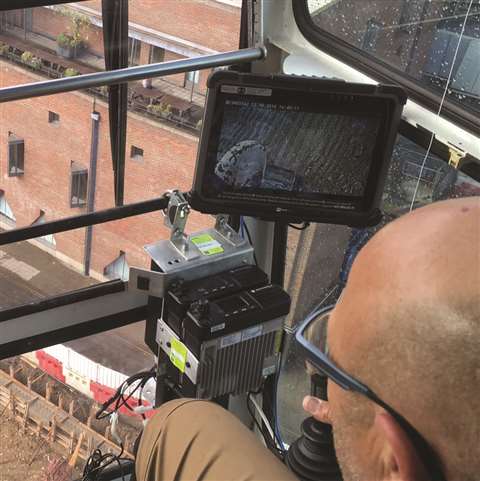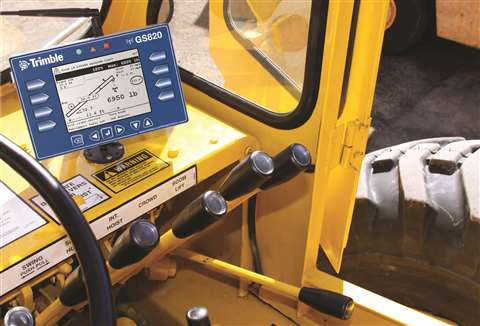Extrasensory perfection
09 May 2017

We perhaps take our senses for granted. Our sense of sight, sound and touch have evolved over hundreds of thousands of years, placing us at the top of Darwin’s tree of life. They helped our prehistoric ancestors avoid danger while migrating out across the plains of Africa, and today they help crane operators safely navigate the urban jungle as they work. Yet, as we will discover, thanks to modern technology an operator’s senses can be enhanced, evolution accelerated if you like, assisting them to work more efficiently and in greater safety than ever before.
“Anything that makes the operator’s job safer and easier is worth it,” says Kris Houg, a crane operator at US contractor the Boldt Company. “That’s why I specifically requested using a camera for this job.” The job Houg is referring to was a power plant renovation in Minnesota, where he was operating a 550 US ton (500 tonne) capacity Demag CC 2500-1 lattice boom crawler crane with 551 feet (168 metres) of boom. Access to the power plant was through the roof, which was 22 storeys high. A typical lift involved taking material from the ground, lifting it up and in through the roof, and then down four storeys.
When operating the crane, Houg was in constant radio communication with the ground crew who helped guide him in. Thanks, however, to the use of a wireless camera mounted on the hook, Houg had a better view than anyone else on the job site. “My team can signal that I need to swing right but when I’m looking straight down using the camera view I can know with even greater accuracy where I need to be,” Houg says.

Cranesmart produces a range of wireless operator assistance devices to help improve safety and efficiency
The camera Houg requested was the HoistCam system made by US company Netarus LLC. The HoistCam range also includes boom tip cameras and winch cameras to give the crane operator a 360-degree view.
Houg’s sentiments are echoed by UK company BlokCam which produces a wireless camera system (also called BlokCam), that it says can be quickly and easily deployed to the hook block or boom tip of a crane. The sound and view from below the camera is wirelessly transmitted to a screen in the cab, allowing the operator to see and hear the load and surroundings, giving an unobstructed, live, audio-visual feed of the critical areas that working in the blind would never allow. According to Ben Windass, co-owner and joint managing director at BlokCam, “Tower crane manufacturers, rental companies and contractors are increasingly embracing crane camera technology to enhance safety and efficiency on their job sites.” Indeed, a recent retweet on the company’s Twitter feed (twitter.com/BlokCam) from Aaron Bauer, a crane operator from Massachusetts, USA, proclaims, “First pick of the morning in the blind with my brand new BlokCam… I love this crane camera.”
The development of wireless technology, however, has not only brought innovations in terms of cameras; other areas with operator assistance applications are benefitting, too. For example, Canadian crane safety equipment manufacturer Cranesmart Systems produces a wide range of operator assistance devices that use wireless, radio communication technology. These include: its Anti-2-Bloc branded sensor, designed to help prevent collisions between a travelling block and the tip of the crane boom; load cells, load pins and line riders; angle indicators; level indicators; and windspeed indicators.
Cranesmart says these systems help provide and maintain a much safer working environment, as well as meeting jobsite regulations worldwide, by making critical operational data readily available to the operator and offering function lockouts.
Function lockouts

Trimble’s, GS820 display and receiver can monitor up to 32 sensors and the operator can view up to 20 data fields
A function lockout provides the ability to stop machine operations to avoid dangerous situations more quickly than the combination of a warning system and operator reaction, Cranesmart says. It adds that, when properly designed, safety systems that override functions should never impede an operator’s ability to do the job unless an accident is imminent. The company also says interlocking safety systems also aid less experienced operators who may not choose the correct action to avoid a dangerous situation or who could damage equipment.
Cranesmart’s systems use both visual and audible alarms to indicate potential dangers. The company has also developed a new colour touchscreen display panel which it claims makes information easier to navigate and see in all lighting conditions. Users will also be able to swap out components on the fly so that if any system component fails, a spare unit can be integrated by scanning its ID number through the display panel. Once the panel receives information from the newly transmitting component, operation will resume. The new LMI 4 system also allows a supervisor to configure the lifting restrictions imposed on operators, as well as download data logs via a USB port, says Cranesmart.
“Technology has improved drastically over the past few years and operators are becoming accustomed to using touchscreen devices like cell phones and smart tablets,” says Dean Raboud, a spokesperson for Cranesmart. “This has trended toward a greater acceptance of operator aids and safety systems in the industry. Colour touchscreens allow for a simpler user interface and the systems are becoming much easier to use.”
Integrated solutions
This is something that positioning technology specialist Trimble is in agreement with. Trimble offers the lifting industry wireless RCI and LMI (rated capacity and load moment indicator) systems, including a range of sensors and displays designed to improve safety. “The industry is definitely moving towards integrated solutions,” says Anne-Marie S. Latvatalo, marketing co-ordinator at Trimble’s Lifting Solutions division. “As machines become more advanced, the control devices and HMIs (human-machine interface displays) have to evolve as well. The operator needs as much visibility as possible and adding more displays can clutter their view of the work. Additionally, aesthetics are playing a bigger role than ever before.”

Experienced operators are key, even when using anti-collision systems, says McKee Communications
Trimble’s systems are also wireless and the company says they offer a long communication range between the sensor and display - typically around 4,300 feet (1,300 m). “Using our systems operators can monitor several kinds of load data at once, load management can be optimised, and data can be logged,” says Latvatalo. In addition, the systems’ data logging functions can track machine usage and provide information about a crane’s operation leading up to an accident, if one were to occur.
Trimble’s systems also have visual and audible alarms that can alert the operator in case of events such as dangerously high wind speed, a two-block situation, or an over-capacity lift. If the crane has solenoid valves, Trimble systems can trip lockouts when limits are exceeded to shut down crane movement.
Trimble points out that the technology is an assistance device only and that caution must always be used when operating a crane. This is echoed by McKee Communications, a USA-based company that has been providing communications systems to the crane industry since 1985. “An anti-collision system is an operator aid only and is not a substitute for an experienced operator,” says company president, Peter McKee. “In practice, the system is often overridden or disconnected in order to complete the task at hand. Therefore the anti-collision system should be an alarm only, rather than stopping a function. Ideally, the alarm would be both visual and audible with an ‘acknowledge’ button to silence or extend the alarm to 20 to 30 second intervals. The ‘acknowledge’ feature is necessary because the crane may need to be in a certain position for an extended length of time.”
The need for an alarm-only ‘acknowledge’ feature also applies to wind alarms, McKee says. For example, a crane may be holding a load in position which cannot be cut loose until the load is secured and so interrupting the swing function could create a hazard.
“In practice, in the absence of an alarm-only feature with an acknowledge button, operators have bypassed the anti-collision system using a plug provided by the manufacturer and only removing the plug during inspections. The absence of these features needs to be addressed in order for the anti-collision systems to contribute to safety improvements,” says McKee.
McKee Communications stresses that anti-collision systems do not eliminate the need for experienced operators. It claims that on multiple crane projects, nothing is as crucial to job site safety as a clear and dedicated communication system between experienced crane operators. When working close to power lines, a dedicated spotter is also required and a clearly marked line should indicate the closest approach distance. “Keeping the hoist line and block out of the danger zone does not guarantee safety,” says McKee. “For example, the load under the hook block may be an oversized load that provides a large enough area to be caught by the wind, adding 20 to 30 feet to the hazard area. Good judgment by the operator and his signalman, in addition to a secure communication system with sufficient tag-lines to control the load, is crucial in preventing a disaster.”
According to McKee Communications, in recent years, government safety departments throughout the USA have required a hard-line communication system be installed even if an anti-collision system is being used. “Anti-collision systems are not fail-safe, neither are radios. Even if the radios are on a secure channel and fully charged, they are not hands-free. By the time the operator has located the radio and pushed the talk switch, and providing the radio is not already in use by another user, a collision could be inevitable,” warns McKee. By installing a dedicated hard line between the cranes and a foot-operated, hands-free switch, McKee says, the operator can sound the warning immediately which could mean the difference between an accident happening or not.
So, although devices are being called upon more than ever before to assist operators and prevent accidents, it seems no one technology can yet replace a ground crew. “Systems always include a disclaimer placing the ultimate responsibility for safety with the operator,” points out McKee. With this in mind, any extra assistance the operator can receive is going to be welcome.




